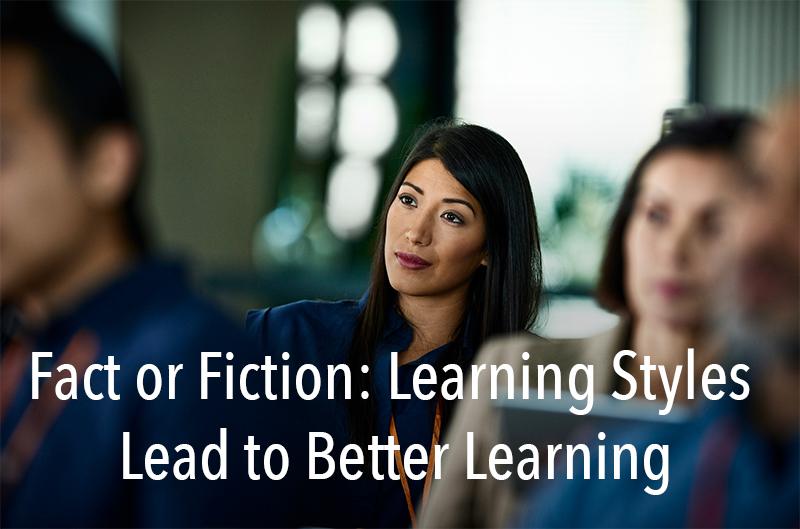
Have you ever been pushed into group work even though it wasn’t necessary for the task? Or build a 3-D model of your department’s workflow? Such activities may trigger a learner’s perceived learning preferences—auditory, visual, verbal, interpersonal, kinesthetic (tactile/physical)–but don’t result in better recall of the learning information. Educators and education institutions have long believed that learning styles not only matter but are the key to effective learning. Many educators have been encouraged to create learning experiences based on these “styles” to improve learning outcomes. But, do such experiences actually result in better learning? And, do these learning styles help instructors understand how learning actually happens?
An individual’s learning style can be determined by a learning inventory questionnaire, typically VARK or Index of Learning Styles. Instructors use the insights from these questionnaires to tailor their instruction to meet the perceived learning styles of their audience. While this knowledge is interesting, a learner’s perceived learning style should not be the sole determining factor for instructional methodology or keep educators from teaching in a manner best suited to their content. Learning styles should be viewed as learner preferences, not stand-alone requirements for learning.
Many learners believe they can only learn via a specific style. For example, after taking the questionnaire, a learner is told she is an auditory learner and should listen to lectures in order to learn the information well. Another learner believes he is a visual learner and says, “I can only learn if there are videos.” A test went well for another learner because he used hand-made flashcards, so he believes he is a verbal learner. Yet another learner reviewed for an exam by building models of molecules out of pipe cleaners and cotton balls, so he believes he is a kinesthetic learner. However, years of research calls these claims into question. In a study published in 2017 researchers found that there is actually no association with performance and a learner’s believed learning style, or rather preference. In fact, this persistent belief in learning styles is due to a type of cognitive bias known as confirmation bias: a learner believes something to be true, and when the belief is confirmed by observation, she neglects contrary evidence.
Harold Pashler, Mark McDaniel, Doug Rohrer, and Robert Bjork published work in 2009 that concluded, “there is no adequate evidence base to justify incorporating learning-styles assessments into general educational practice” (2009).
However, learning styles shouldn’t be disregarded entirely. Instead, they should be tied to the content rather than the learner. In other words, a play should not be just read, but performed. Art is to be seen and experienced. Anatomy and physics should be practiced in a laboratory. The incorporation of different learning styles when aligned with the content likely will increase engagement from the learner. Additionally, educators must understand what is going on in the brains of their learners in order to make their instruction more effective.
The brain does not work in isolation: visual cues aren’t interpreted separate from auditory cues. Signals from all senses are transmitted simultaneously into neural pathways where memories are formed. Learning occurs when these memories are retrieved. Memories are made after associations (emotional, physical, etc.) have been formed and the act of retrieval has been practiced. Forgetting (when the brain is unsuccessful in retrieving the information it is looking for) may seem like a bad thing, but is a powerful force that encourages deeper memory formation.
So what should educators do? Create learning experiences based on the content and utilize proven methodologies that foster long-term learning: metacognition, retrieval, feedback, direct instruction, and application. The delivery of content should consider how to maximize learner engagement, which leads to increased curiosity and in turn, memory formation, while remaining focused on the objective. Know your audience, but also know the science of cognition. Deliver instruction that cues the neural pathways that create long-term connections within the brain, sparking memory-formation and a thirst for more.







